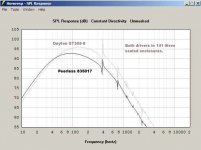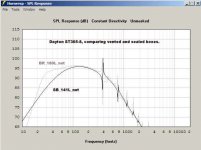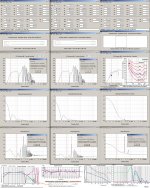Friends,
I need your help selecting subwoofer drivers for a pair of 5 cu ft. sealed subs I am building for a friend. Each sub will be powered by a GR Research plate amp that has 5 db of gain at 25Hz built in:
SA-1
The goal is clear: natural, punchy, detailed bass at very low listening levels for music only.
General guideline:
5 cu ft, sealed boxes
Push Pull, 2x12" drivers per box
100-120Hz, 12db/oct lowpass crossover
I am trying to get an idea of what driver parameters contribute to the ability of a driver to meet the above sound requirements.
Given that I will select between various 12" woofers for this project, I am looking for a combination of:
high Qms
high BL
low Moving mass
high Sensitivity
high Vas
I am correct? Do some parameters need special attention or priority?
If I am correct than the Dayton 12" Series II seems to fit the bill, even though it's not a fancy driver.
http://www.parts-express.com/pdf/295-120s.pdf
however, it has a high inductance value (is that important for the 100 Hz crossover point?)
Thank you in advance,
Herman
I need your help selecting subwoofer drivers for a pair of 5 cu ft. sealed subs I am building for a friend. Each sub will be powered by a GR Research plate amp that has 5 db of gain at 25Hz built in:
SA-1
The goal is clear: natural, punchy, detailed bass at very low listening levels for music only.
General guideline:
5 cu ft, sealed boxes
Push Pull, 2x12" drivers per box
100-120Hz, 12db/oct lowpass crossover
I am trying to get an idea of what driver parameters contribute to the ability of a driver to meet the above sound requirements.
Given that I will select between various 12" woofers for this project, I am looking for a combination of:
high Qms
high BL
low Moving mass
high Sensitivity
high Vas
I am correct? Do some parameters need special attention or priority?
If I am correct than the Dayton 12" Series II seems to fit the bill, even though it's not a fancy driver.
http://www.parts-express.com/pdf/295-120s.pdf
however, it has a high inductance value (is that important for the 100 Hz crossover point?)
Thank you in advance,
Herman
I need your help selecting subwoofer drivers for a pair of 5 cu ft. sealed subs I am building for a friend. The goal is clear: natural, punchy, detailed bass at very low listening levels for music only.
Given that I will select between various 12" woofers for this project, I am looking for a combination of:
high Qms
high BL
low Moving mass
high Sensitivity
high Vas
I am correct? Do some parameters need special attention or priority?
Bass and low SPL doesn't go together - introduce yourself to Fletcher and Munson - probably the best bet for punch at low listening levels is a speaker that is peaky at 60-80Hz and distorts a lot. You could do that with 6"ers in a 0.5 cubic foot box like BOSE does.
gosh Ron, how can you say that
but then, I prefer bass that I can hear, rather than feel
I like detailed bass
different approach I guess
but it is possible to have very nice clean bass at very low SPL
but the whole speaker have to stay balanced
and I would suggest a relatively big woofer
and leave out the sub
but then, I prefer bass that I can hear, rather than feel
I like detailed bass
different approach I guess
but it is possible to have very nice clean bass at very low SPL
but the whole speaker have to stay balanced
and I would suggest a relatively big woofer
and leave out the sub
Friends,
I need your help selecting subwoofer drivers for a pair of 5 cu ft. sealed subs I am building for a friend. Each sub will be powered by a GR Research plate amp that has 5 db of gain at 25Hz built in:
SA-1
The goal is clear: natural, punchy, detailed bass at very low listening levels for music only.
General guideline:
5 cu ft, sealed boxes
Push Pull, 2x12" drivers per box
100-120Hz, 12db/oct lowpass crossover
I am trying to get an idea of what driver parameters contribute to the ability of a driver to meet the above sound requirements.
Given that I will select between various 12" woofers for this project, I am looking for a combination of:
high Qms
high BL
low Moving mass
high Sensitivity
high Vas
I am correct? Do some parameters need special attention or priority?
If I am correct than the Dayton 12" Series II seems to fit the bill, even though it's not a fancy driver.
http://www.parts-express.com/pdf/295-120s.pdf
however, it has a high inductance value (is that important for the 100 Hz crossover point?)
Thank you in advance,
Herman
Hi,
All your wanted parameters except Qms will increase max SPL at the cost
of bass extension for a driver suited to a sealed 5 cuft box. As you state
low listening levels are required that means you could use lower efficiency
drivers in a far smaller box, and smaller drivers, noting maximum SPL is
determined by total cone area x excursion, match this to the amp power.
Doing some modelling in WinISDpro should help a lot.
rgds, sreten.
Hi noviygera,
Take a look at the Parts-Express woofer selection guide:
Woofer Selection Guide at Parts Express
In the Sealed F3 Hz column, e.g.: for a 12" woofer you'll find the Peerless 835017 with an F3 of 49 Hz.
Regards,
Take a look at the Parts-Express woofer selection guide:
Woofer Selection Guide at Parts Express
In the Sealed F3 Hz column, e.g.: for a 12" woofer you'll find the Peerless 835017 with an F3 of 49 Hz.
Regards,
What kind of music? Qts is more important overall than Qms. (unless you are using tube amps and like distortion...)
for rock n roll i'd use the push/pull 12's
for classical i'd use stereo single 15's (DCS385-4 15 in a 5ft^3 box half filled with polyfill and enough bracing to hold up a truck)
for rock n roll i'd use the push/pull 12's
for classical i'd use stereo single 15's (DCS385-4 15 in a 5ft^3 box half filled with polyfill and enough bracing to hold up a truck)
OK, threshold of hearing bass in a room is after Robinson-Dadson or ISO 226:2003. Equal-loudness contour - Wikipedia, the free encyclopedia A person can hear 20Hz (threshold) at ~75dB, and 100Hz at ~20dB, I would guess a typical "low" level to be <60dB, which means that frequencies below 30Hz would be essentially inaudible, and in most rooms, where the noise floor might be 40dBC, you are looking at sounds into the 60 Hz range that may be pretty difficult to detect.
My response was somewhat tongue in cheek, but it is one way to skin a cat. Multiple coffin sized boxes with dual 12" woofers will make bass, but even one in 1 cubic foot will probably make enough for the application. There are no magic parameters and perhaps a discussion of the true goals and implicit assumptions of the project would be pertinent.
My response was somewhat tongue in cheek, but it is one way to skin a cat. Multiple coffin sized boxes with dual 12" woofers will make bass, but even one in 1 cubic foot will probably make enough for the application. There are no magic parameters and perhaps a discussion of the true goals and implicit assumptions of the project would be pertinent.
What I am trying to achieve is the pressurizing of the room effect, at low volumes. Plus the nuanced bass and detail along with that. Is that not a reasonable desire?
I know some people measure the bass in spl but there is more to that, like if you close your ears, you can feel the bass impact even at quiet levels. this is what I am talking about.
I know some people measure the bass in spl but there is more to that, like if you close your ears, you can feel the bass impact even at quiet levels. this is what I am talking about.
Hi,
Just for the fun of it, a quick comparison between the Dayton ST305-8 and the Peerless 835017 in the same dual/sealed 141 litres box. With the additional bass boost the Peerless should provide excellent quality bass. The peak output of the Dayton is a bit high, it would have to be reduced to arrive at a level response.
Regards,
Just for the fun of it, a quick comparison between the Dayton ST305-8 and the Peerless 835017 in the same dual/sealed 141 litres box. With the additional bass boost the Peerless should provide excellent quality bass. The peak output of the Dayton is a bit high, it would have to be reduced to arrive at a level response.
Regards,
Attachments
I think I am set
the Dayton Audio ST305-8 12" Series II will be an in between the PA type and the audiophile sub type, it's got the "almost PA" sensitivity of 92db.
Dayton Audio ST305-8 12" Series II Woofer
Again not a fancy driver but I will post my results.
Thanks for the input guys!
Best regards,
Herman
the Dayton Audio ST305-8 12" Series II will be an in between the PA type and the audiophile sub type, it's got the "almost PA" sensitivity of 92db.
Dayton Audio ST305-8 12" Series II Woofer
Again not a fancy driver but I will post my results.
Thanks for the input guys!
Best regards,
Herman
Hi,
There is some good common sense in this thread and some pure conjecture.
Though Qts is far more influential.
but its all relative in the end.
but its all relative in the end.
all being relative, Fb choice and sensitivity determines the box size.
FWIW I'd recommend for best sound quality two separate boxes,
each with two drivers in force cancelling mode. Not necessarily
push/pull, but this can also be done if wanted.
Put the plate amp in one box, add a socket for the other box.
Place the subs somewhere between a 1/3 and a 1/4 along
the back wall and the same along the opposite side wall.
(Assuming they will not be moved out into the room.)
Something filtered at 100Hz has no speed whatsoever. To get that
is nearly all about integration to the mains + using a low Q sealed
alignment (especially as your adding some bass boost).
As excursion quadruples each octave you drop, and the loudness
curves add further excursion requirements, for very low bass the
important parameter (given others are OK) is volume displacement.
Cone area x excursion should be maximised - PA drivers are specifically
not designed to do this, its not in their proper job description, which
is maximising SPL in the power limited region, not the excursion region.
For going at very low bass sensitivity should be chosen such that the
amplifier power can max out the excursion at your chosen lf target.
Very likely this will not be the drivers thermal power handling.
Given the above, driver choice then depends on the box size chosen.
rgds, sreten.
There is some good common sense in this thread and some pure conjecture.
Generally a good thing in a driver,: high Qms
Though Qts is far more influential.
Again generally a good thing in a driver.: high BL
Generally a bad thing for a subwoofer, it increases Fs,: low Moving mass
but its all relative in the end.
Generally a bad thing for a subwoofer, it increases Fs,: high Sensitivity
but its all relative in the end.
Generally a bad thing for a subwoofer, it increases the box size needed,: high Vas
all being relative, Fb choice and sensitivity determines the box size.
FWIW I'd recommend for best sound quality two separate boxes,
each with two drivers in force cancelling mode. Not necessarily
push/pull, but this can also be done if wanted.
Put the plate amp in one box, add a socket for the other box.
Place the subs somewhere between a 1/3 and a 1/4 along
the back wall and the same along the opposite side wall.
(Assuming they will not be moved out into the room.)
Something filtered at 100Hz has no speed whatsoever. To get that
is nearly all about integration to the mains + using a low Q sealed
alignment (especially as your adding some bass boost).
As excursion quadruples each octave you drop, and the loudness
curves add further excursion requirements, for very low bass the
important parameter (given others are OK) is volume displacement.
Cone area x excursion should be maximised - PA drivers are specifically
not designed to do this, its not in their proper job description, which
is maximising SPL in the power limited region, not the excursion region.
For going at very low bass sensitivity should be chosen such that the
amplifier power can max out the excursion at your chosen lf target.
Very likely this will not be the drivers thermal power handling.
Given the above, driver choice then depends on the box size chosen.
rgds, sreten.
Last edited:
Again not a fancy driver but I will post my results.
looks about right for your demands
but try to avoid boomy sound
I would suggest closed box with system Qtc around 0.55
Hi noviygera,
By building the box with a vented alignment in mind you would give yourself the option of tuning after the fact. The ST305-8 does model fine in a slightly larger BR enclosure. And, as you are using two drivers per box, you may also take a look at djk's PPSL:
http://www.diyaudio.com/forums/subwoofers/177905-thread-those-interested-ppsl-enclosures.html
Regards,
By building the box with a vented alignment in mind you would give yourself the option of tuning after the fact. The ST305-8 does model fine in a slightly larger BR enclosure. And, as you are using two drivers per box, you may also take a look at djk's PPSL:
http://www.diyaudio.com/forums/subwoofers/177905-thread-those-interested-ppsl-enclosures.html
Regards,
Attachments
noviygera,
Hi,
I think your choice of drivers is good., sreten made the consequences quite clear. Some of the parameters could been chosen differently:
That is if a smaller box with a lower cutoff frequency would be of more important than what your driver parameters implies.
My investigation of your driver choice point toward a Ported box,very large TH a T-TQWP or my own preference for a sub: a T-TQWT.
You probably know that a high Qm value is a measure of low mechanical losses,i.e. low stored energy.
Drivers with values above 10 are considered to be very good.
A push-pull arrangement of 4 drivers in a 10 cu.ft closed box(i.e. tinnitus choice of Qtc) is both level/distortion suppression-wise comparable with one in a ~3.75 cu.ft T-TQWT that is ~62% smaller than the closed one and ~ similar performance at ~30 Hz if tested in a very large room(high ceiling height) and away from room corners and other objects that could influence the FR.
IME If the subs are compared placed anywhere in an ordinary furnished room,the FR/impression performance of the T-TQWT would outperform the closed box.
The fact(IME) it's very insensitive for picking up any load influence that would change the sound character' as a big closed box and most other box types do.
A forth order BP box is an exception. Hint o a pressure source
o a pressure source
to boundary interaction analysis.
See the picture:
b
Hi,
I think your choice of drivers is good., sreten made the consequences quite clear. Some of the parameters could been chosen differently:
That is if a smaller box with a lower cutoff frequency would be of more important than what your driver parameters implies.
My investigation of your driver choice point toward a Ported box,very large TH a T-TQWP or my own preference for a sub: a T-TQWT.
You probably know that a high Qm value is a measure of low mechanical losses,i.e. low stored energy.
Drivers with values above 10 are considered to be very good.
A push-pull arrangement of 4 drivers in a 10 cu.ft closed box(i.e. tinnitus choice of Qtc) is both level/distortion suppression-wise comparable with one in a ~3.75 cu.ft T-TQWT that is ~62% smaller than the closed one and ~ similar performance at ~30 Hz if tested in a very large room(high ceiling height) and away from room corners and other objects that could influence the FR.
IME If the subs are compared placed anywhere in an ordinary furnished room,the FR/impression performance of the T-TQWT would outperform the closed box.
The fact(IME) it's very insensitive for picking up any load influence that would change the sound character' as a big closed box and most other box types do.
A forth order BP box is an exception. Hint
to boundary interaction analysis.
See the picture:
b
Attachments
- Status
- This old topic is closed. If you want to reopen this topic, contact a moderator using the "Report Post" button.
- Home
- Loudspeakers
- Subwoofers
- Driver parameters for detailed bass at quiet levels.


